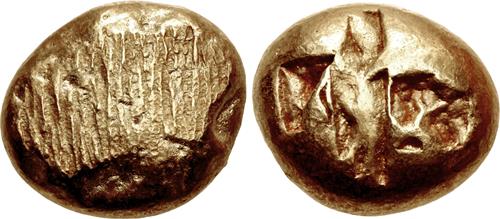|
IONIA, Uncertain. Circa 650-600 BC. EL Hemistater (14mm, 7.17 g). Lydo-Milesian standard. Flattened striated surface / Two incuse squares flanking central rectangular incuse. Weidauer Group II, unlisted denomination; Linzalone LN1027 (this coin); Linzalone LN1028 = Triton IX, lot 939; CNG 72, lot 748 (same incuses); Triton VIII, lot 432; CNG 70, lot 271 (same incuses); CNG 69, 421 (same incuses); CNG 67, 702 (same incuses); otherwise unpublished in the standard references as a hemistater. Good VF. Extremely rare, fewer than 10 hemistaters known for this issue.
From the Jonathan P. Rosen Collection. Ex Classical Numismatic Group 70 (21 September 2005), lot 271.
The same rectangular punch was used on staters of this issue (cf. CNG 70, lot 270), as well as trites, where the square punches were also used (cf. CNG 70, lot 272).
Other than the literary tradition ascribing the origin of coinage to the kings of Lydia, there is little evidence for a more exact chronology of early Greek coinage. The tradition, buttressed by limited archaeological studies, does confirm Asia Minor as the place of origin, most likely Lydia or Ionia, and a date somewhere around 650-625 BC. The alloy used was a mixture of gold and silver known to the Greeks as elektron. Although ancient sources indicated that this alloy was a natural ore found in nugget form in many riverbeds in the region, recent studies have concluded that this was actually not the case, and that the electrum used in coinage was, in fact, man-made. The earliest coins were of a globular shape and without design; later, simple striated and punched patterns of squares, rectangles, and swastikas were included. The earliest true types may have developed from the use of personal seals, the most widely known being the stater of Ephesos with a stag bearing the inscription “I am a seal of Phanes” (see lot 350 above). These devices later took on the characteristics of civic symbols, although it would be dangerous to link a specific symbol to a particular city in this early period. The most secure form of classification has been by weight standard, based on two major, and several lesser-used, standards. The Milesian standard, with a stater of roughly 14 grams, saw circulation in Lydia and parts of Ionia. The Phokaic standard of roughly 16 grams was also used in Ionia as well as Mysia. Persic, Aeginetan, and Euboic standards saw scattered use in early coinage, limited in time and extent of circulation. The intrinsic value of the early electrum, even down to the 1/96 stater, was too high for use in everyday commerce, and early coinage must have been used only for the transfer of large sums of money, such as mercantile transactions, payment of government expenses (mercenaries, tribute and such), and donatives, either for services rendered to individuals or the state, or to religious foundations. The Artemision deposits, hoards of early electrum found at the site of the temple of Artemis at Ephesos, are examples of the latter.
The final winners of all Triton XXIII lots will be determined at the live public sale that will be held on 14-15 January 2020. Triton XXIII – Session Two – Greek Coinage Part II through Roman Imperial Coinage Part I will be held Tuesday afternoon, 14 January 2020 beginning at 2:00 PM ET.
Winning bids are subject to a 20% buyer's fee for bids placed on this website and in person at the public auction, 22.50% for all others.
|
